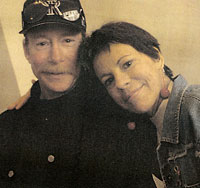And The Beat Goes On
Given the July decision, it may seem surprising that so few of Jack Kerouac’s Beat Generation friends and acquaintances advocated for a closer look at Gabrielle’s will. Dadaist poet and friend of Jan Kerouac, Carl Macki, explained that as Jan became more passionate and determined to proceed with her legal case, she had also “grown increasingly defiant towards the Sampas family and those close friends of her father who betrayed her in the struggle over the will of her grandmother.” In fact, as Jan was preparing her case against the Sampas family in the early 1990s, Allen Ginsberg told the writer Aram Saroyan that Jan’s appeal was fruitless, and that he personally had spent “several days researching” the charges and found no basis in Jan’s opposition. This view was backed up by the majority of the Beats, with the exception of the poet Gregory Corso, who was one of the few who signed a petition to enable Jan to speak at a Kerouac conference in New York in 1995. As it turned out, she wasn’t granted permission and was thrown out of the conference when she approached the microphone to say a few words about the value of preserving her father’s original papers.
Some Kerouac scholars attribute this to the power and influence of the Sampas family, who have watched the value of the Kerouac estate increase exponentially. Brenda Knight, author of Women of the Beat Generation, said she believes that many of Jack Kerouac’s friends “were worried about getting ‘blacklisted’ in an unofficial way.” The Sampas family owned “one of the most valuable literary estates in the world,” she said, and could be a powerful force that a less commercially successful writer or poet might not want to provoke.
Perhaps many of these writers were afraid to align themselves with the daughter of Jack Kerouac, especially when he himself had only seen his daughter twice in his life. Nicosia recalled specific examples of inaccurate stories he believed were “placed by the Sampas family,” including a story in the Boston Herald about Jan being an “illegitimate daughter.”
Sampas, however, believes he has been mischaracterized. In a previously published interview, he said, “I'm a nobody. They make me out to be some powerful Mafia character. I'm just Jack Kerouac’s brother-in-law.” More recently, he reacted to Nicosia’s claims by retorting “Nicosia is a well known ‘nut case’ who has been stalking the Kerouac estate for years.”
One can only guess at how things might have evolved had the will not been forged, but it’s likely that Jan would have had money to treat her health problems, and Blake might have avoided homelessness and poverty. Before the forgery verdict, Blake himself couldn’t understand why his beloved grandmother Gabrielle wouldn’t have provided for him in her will. At the very least Blake thought he would have received a baseball card game his uncle made which they often played together. The Sampas family have repeatedly said they would have gladly helped Blake with money if he had asked them directly instead of pressing ahead with Jan Kerouac’s court case.
For sure, there was lots of money to go around. In the early nineties when John Sampas took over the estate from Stella, he enlisted the help of Massachusetts bookshop owner Jeffrey Weinberg to value Kerouac memorabilia, including letters, signed editions, and drafts. According to Weinberg, Sampas told him, “I want to turn some of this stuff into cash.” And they did. To the consternation of some Kerouac fans, at the height of Kerouac’s popularity, actor Johnny Depp dropped more than $40,000 on various Kerouac items, including a trench coat, a hat, and a suitcase when he visited the Kerouac estate. Then, in 2001, the Sampas family sold the original scroll of what many consider Kerouac’s masterpiece, On The Road, to James Irsay, owner of the Indianapolis Colts, for $2.43 million.
The sell-off to private collectors explains why some scholars and fans have negative feelings about the Sampas family. Nancy Grace, author of Jack Kerouac and the Literary Imagination (2007), said, “Many Kerouac scholars have long thought that John Sampas was milking the estate for every penny he could get and that he didn’t care about genuine scholarship at all, or Kerouac for that matter.”
Even more frustrating for scholars has been the loss or lack of access to several items, such as the original scroll of On The Road—which has been shipped around the world in a locked glass case—or any complete draft of The Dharma Bums, Big Sur, and Vanity of Duluoz, all of which have either been sold to private collectors or remain unaccounted for. Ann Charters, author of the first biography of Kerouac, explained, “I don’t think Kerouac’s unpublished papers should be sold off to private collectors; they should be made available to scholars ASAP.” She added that his “nonconformist style of writing his fictional autobiography makes it imperative for scholars to have access to the ‘first draft’ manuscripts.”










